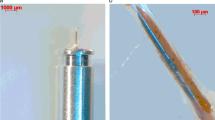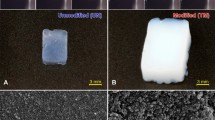Abstract
Silica gel provides a useful medium for crystal growth; solution growth is confined to pores left free by the polymer during its development. All growth steps depend on the gel structure, which is not completely known for crystal growth conditions. Therefore, a three-dimensional (3-D) visualization has been performed for two TMOS aqueous gels, which are rather fragile: the quick-freeze, deep-etching, rotary-replication method has been applied for sample preparation. An original surface labeling technique has been used for surface recognition. The results concern the distribution of macropores that are responsible for crystal nucleation; micropores whose total volume is larger have not been visualized due to the limits of the method. These results are discussed in comparison with previous data performed by light scattering.
Similar content being viewed by others
References
Henisch HK, Crystals in gels and Liesegang rings (1988) Cambridge University Press
Andreazza P, Lefaucheux F, Mutaftschiev B (1988) J Cryst Growth 92:415–422
Lefaucheux F, Robert MC, Bernard Y (1988) J Cryst Growth 88:97–106
Lefaucheux F, Robert MC, Gits S, Bernard Y, Gauthier Manuel B (1986) Rev Int Haut Temp Refrac 23:57–67
Quinson JF, Dumas J, Serrughetti J (1986) J Non Crystalline Solids 79:397–404
Dubois M, Cabane B (1989) Macromolecules 22:2526–2533
Terech P, Volino F, Ramasseul R (1985) J Physique 46:895–903
Himmel B, Gerber Th, Burger H (1990) J Non Crystalline Solids 119:1–13
Rüchel R, Steere R, Erbe E (1978) J Chromatography 166:563–575
Nixon P, White J, Hem S (1987) J Colloid and Interface Science 120, 2:312–319
Muller T, Hakert H, Eckert Th (1989) Colloid and Polym Sci 267:230–236
Heuser J (1979) J Cell Biol 81:275–300
Heuser J (1981) in: Turner JN (ed.) Methods in Cell Biology. Academic Press, New York-22, pp 97–122
Wade RH, Terech P, Hewatt EA, Ramasseul R, Volino F (1986) J Colloid Interface Sci 114:442–451
Favard P, Lechaire JP, Maillard M, Favard N, Djabourov M, Leblond J (1989) Biol Cell 67:201–207
Cabane B, Dubois M, Lefaucheux F, Robert MC (1990) J Non Crystalline Solids 119:121–131
Miller KR, Prescott CS, Jacobs TL, Lassignal NL (1983) J Ultrastruct Res 82:123–133
Escaig J (1982) J Microscopy 126:221–229
Gilkey JC, Staehelin LA (1986) J Electron Microsc Tech 3:177–210
Marraud A (1965) Soc Fr Photogrammétrie Bull 17:7–15
Turner JN (1981) in: Turner JN (ed.) Methods in Cell Biology. Academic Press, New York-22, pp 1–11
Cabane B, Dubois M, Duplesis R (1987) J Physique 48:2131–2137
Gits-Leon S, Lefaucheux F, Robert MC (1987) J Cryst Growth 84:155–162
Quinson JF, Tchipkam N, Dumas J, Bovier C, Serrughetti J (1988) J Non Crystalline Solids 100:231–235
Author information
Authors and Affiliations
Rights and permissions
About this article
Cite this article
Favard, P., Lechaire, J.P., Maillard, M. et al. 3-D-electron microscopy configuration of TMOS wet silica gels prepared by the quick-freeze, deep-etching-rotary-replication technique. Colloid Polym Sci 270, 584–589 (1992). https://doi.org/10.1007/BF00658289
Received:
Accepted:
Issue Date:
DOI: https://doi.org/10.1007/BF00658289




